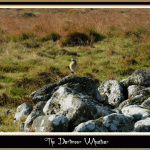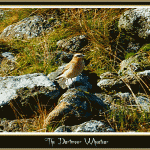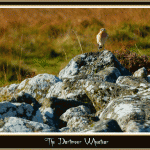
One sure sign that Spring has arrived is the shrill warbling of a colourful bird usually sat atop a rock or boulder, this is the Wheatear. When you look carefully at this small bird you could be forgiven for wondering what about its appearance could possibly suggest either wheat or an ear or even an ear of wheat. The reason for this is because the name had been corrupted from the old word whiteers which is formed from whit (white) and ers (arse) this being a reference to its plumage. If you would like a more prosaic name then in Devonshire they are known as Chickells.
If ever you read any of the early ornithological Dartmoor books you will find numerous references to sightings, the thing that amazes me being that many of them give the dates when they were shot. In the case of the Wheatear you see; “Mr Gatcombe examined specimens shot near Plymouth on the 5th of March.” Pidsley, p.5. I can’t see the R.S.P.B. recording such things today.
There are two important things that Wheatears need for a breeding habitat; plenty of rock clitters or stone walls to nest in and areas of short grass in which to feed. At one time Dartmoor had an ample supply of both but in some locations where livestock numbers have been reduced the areas of short grass have declined, this has led to a decline in bird numbers. However despite the decline it is thought that Dartmoor’s numbers equate. to between 4.7% to 6.9% of the UK. Between 1995 to 2008 the Wheatear population nationally has declined by 5%. The species is listed under the
The first Wheatear visitors tend to arrive on Dartmoor around mid-March although the odd bird has been known to arrive earlier. It addition to those birds who spend their time on the moor there are also the ones that stop off on their migrations routes further away. Normally Wheatears look to migrating back to Africa around September time and can be seen in flocks as they depart. As noted above they build their nests either in the small rocky clitter caves or in stone walls. The first clutches of eggs are laid around early May and normally consist of 5 to 6 eggs. It takes 14 days for the female to incubate the clutches and once the chicks are born it takes around 17 days for them to fledge. In a normal year a pair will lay between 2 and 3 broods. The Wheatear’s diet consists of insects, larvae and berries which makes Dartmoor’s whortleberry, rocky clitters the ideal breeding and feeding grounds. The species is listed under the Bern appendix as III which means it’s a protected species and the Bonn Convention appendix as category II which means it would benefit from international cooperation for its conservation. In the UK the wheatear is classified as being amber in the Birds of Conservation review, this means although not conservation is critical it is still of concern.
The Wheatear belongs to the passeriformes order and the the turdidae family with a Latin name of Oenanthe oenanthe. On average the bird measures around 15 cm long with a wingspan of 29 cm and weighs a mere 24 g. They have a variety of song which varies from warbling to tweeting to ticking and is normally sung from a prominent rock or stone. There can be some confusion between Wheatears, Stonechats and Windchats, the British Trust for Ornithology has an excellent identification video on their website.

Pidsley, W. E. H. 1891. The Birds of Devonshire. Exeter: J. G. Commin.
 Legendary Dartmoor The many aspects past and present of Dartmoor
Legendary Dartmoor The many aspects past and present of Dartmoor



